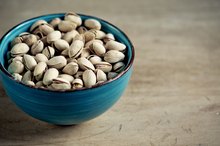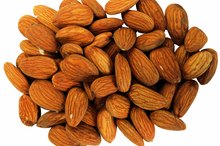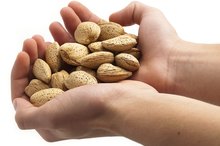What does fact checked mean?
At Healthfully, we strive to deliver objective content that is accurate and up-to-date. Our team periodically reviews articles in order to ensure content quality. The sources cited below consist of evidence from peer-reviewed journals, prominent medical organizations, academic associations, and government data.
- Centers for Disease Control and Prevention: Polyunsaturated Fats and Monounsaturated Fats
- Harvard Medical School: Listing of Vitamins
The information contained on this site is for informational purposes only, and should not be used as a substitute for the advice of a professional health care provider. Please check with the appropriate physician regarding health questions and concerns. Although we strive to deliver accurate and up-to-date information, no guarantee to that effect is made.
Blue Diamond Almonds Nutrition
Blue Diamond Almonds are a healthy alternative to some of those processed snacks you may reach for during your workday 1. They’re full of fiber and protein, which can improve satiety and prevent a rumbling belly. Although the almonds are high in fat, the fats are mainly monounsaturated fats, or MUFAs, a beneficial fat that keeps your heart healthy. While Blue Diamond Almonds do have plenty to offer, measure out a serving instead of snacking freely from the container 1. Otherwise, your calories can quickly add up.
Caloric Breakdown
A single serving of Blue Diamond Almonds is 1 ounce, or about 28 nuts 1. Depending on the flavor, you’ll get between 160 and 170 calories per portion. Most of those calories are from fat, with each serving providing between 13 and 16 grams of fat, or 117 to 144 calories from fat. You’ll also get 5 to 6 grams of protein per ounce, which totals 20 to 24 grams from protein. Most varieties have between 5 and 6 grams of total carbohydrates, although fiber accounts for 3 of those carb grams. Because carbs have 4 calories per gram, after subtracting fiber -- which doesn’t add to the calories -- you’ll get 8 to 12 calories from carbohydrates. The exception is the honey-roasted flavor. This variety has 9 grams of total carbs, minus the 2 grams of fiber, leaving 28 calories from carbohydrates.
- A single serving of Blue Diamond Almonds is 1 ounce, or about 28 nuts 1.
- Most varieties have between 5 and 6 grams of total carbohydrates, although fiber accounts for 3 of those carb grams.
Sodium Details
Good Nuts Vs. Bad Nuts
Learn More
Ideally, you should opt for almonds that aren’t salted so you don’t get too much sodium. But even the flavored varieties of Blue Diamond Almonds aren’t particularly high in sodium 1. You can have up to 2,300 milligrams of sodium daily; any more than that can increase your blood pressure and risk of cardiovascular disease, as stated in the Dietary Guidelines for Americans 2010 2. Whole natural Blue Diamond Almonds offer 0 milligrams of sodium per 1-ounce serving 1. The same amount of the roasted salted kind contains 85 milligrams; an ounce of honey-roasted almonds have 60 milligrams; lightly salted ones have 40 milligrams per ounce; and the Smokehouse flavor is much higher, with 150 milligrams of sodium per ounce. Those in the bold flavor series each contain between 100 and 180 milligrams of sodium per ounce, with the Jalapeno Smokehouse flavor at the highest end of that range.
- Ideally, you should opt for almonds that aren’t salted so you don’t get too much sodium.
- Those in the bold flavor series each contain between 100 and 180 milligrams of sodium per ounce, with the Jalapeno Smokehouse flavor at the highest end of that range.
Mineral Content
Blue Diamond Almonds provide you with several types of minerals 1. One ounce of the almonds gives you up to 20 percent of the magnesium you need for the day. Magnesium keeps your bones and teeth strong, and supports blood functions and biochemical reactions. That same serving contains 5 to 6 percent of your potassium needs, an electrolyte mineral responsible for muscle contractions and a steady heart rhythm. A serving of almonds also provides 6 to 8 percent of the calcium you need for strong bones, as well as 4 to 6 percent of your daily iron recommendation to support oxygen transportation throughout your body.
- Blue Diamond Almonds provide you with several types of minerals 1.
- A serving of almonds also provides 6 to 8 percent of the calcium you need for strong bones, as well as 4 to 6 percent of your daily iron recommendation to support oxygen transportation throughout your body.
Amount of Vitamin E
Shelled Peanuts: Nutrition Facts
Learn More
Vitamin E is a powerful antioxidant that scavenges through your system, seeking out free radicals. When it finds these free radicals, it neutralizes them, preventing permanent cell damage that could have increased your risk of developing chronic diseases. No matter which variety of Blue Diamond almonds you snack on, you’ll get roughly one-third of your vitamin E recommendation for the entire day 1.
- Vitamin E is a powerful antioxidant that scavenges through your system, seeking out free radicals.
- When it finds these free radicals, it neutralizes them, preventing permanent cell damage that could have increased your risk of developing chronic diseases.
Related Articles
References
- Blue Diamond Almonds: Whole Natural Flavor
- U.S. Department of Agriculture and U.S. Department of Health and Human Services: Dietary Guidelines for Americans 2010
- Harvard Medical School: Listing of Vitamins
- Atkinson, FS, Foster-Powell, K, Brand-Miller, JC.International tables of glycemic index and glycemic load values: 2008.Diabetes Care. 2008;31(12):2281-2283. doi:10.2337/dc08-1239
- National Library of Medicine, National Institutes of Health. Dietary Reference Intakes (DRIs): Recommended dietary allowances and adequate intakes, elements.
- Aune D, Keum N, Giovannucci E, et al. Nut consumption and risk of cardiovascular disease, total cancer, all-cause an cause-specific mortality: A systematic review and dose-response meta-analysis of prospective studies. BMC Med. 2016;14(1):207. doi:10.1186/s12916-016-0730-3
- Alasalvar C, Bolling BW. Review of nut phytochemicals, fat-soluble bioactives, antioxidant components and health effects. Br J Nutr. 2015;113 Suppl 2:S68-78. doi:10.1017/S0007114514003729
- Veronese N, Watutantrige-Fernando S, Luchini C, et al. Effect of magnesium supplementation on glucose metabolism in people with or at risk of diabetes: A systematic review and meta-analysis of double-blind randomized controlled trials. Eur J Clin Nutr. 2016;70(12):1354-1359. doi:10.1038/ejcn.2016.154
- American College of Allergy, Asthma & Immunology. Oral Allergy Syndrome. Updated March 2019.
Writer Bio
Melodie Anne Coffman specializes in overall wellness, with particular interests in women's health and personal defense. She holds a master's degree in food science and human nutrition and is a certified instructor through the NRA. Coffman is pursuing her personal trainer certification in 2015.









